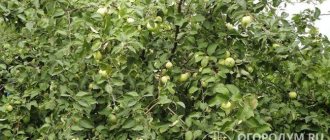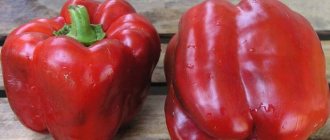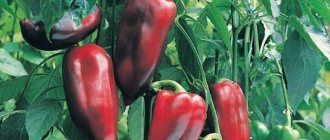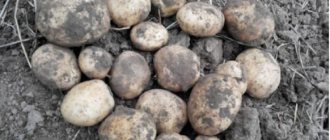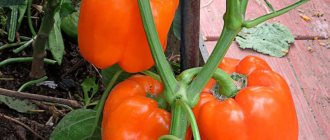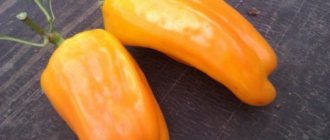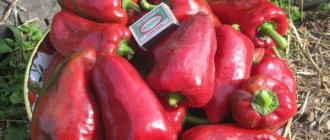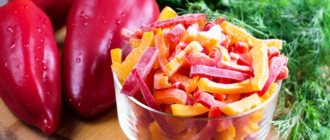Pepper Bogatyr reviews, photos, yield, characteristics and description of the variety of which are presented in this article, is loved by many gardeners, as it is unpretentious in care and produces a rich harvest.
Many manufacturers produce the Bogatyr pepper variety, but they have different data on the appearance of the fruit. states that the peppers are cone-shaped and weigh approximately 80 -130 g. “Siberian Varietal Seeds” state that the peppers are cube-shaped. Agro and Poisk produce seeds of the Bogatyr variety with cone-shaped fruits that weigh up to 200 g. Therefore, when purchasing seeds, carefully read the information from the manufacturer to know what fruits will grow in your garden bed.
Description and characteristics of the variety
The Bogatyr pepper variety was included in the register of agricultural crops of the Russian Federation in 1996.
- The variety was created by the Agrofirm Poisk society from the Moscow region for cultivation. They clearly identified the areas of its cultivation: in the Lower Volga and North Caucasus regions.
- Suitable for growing in greenhouses and open ground.
- The variety is mid-season. The first ripe fruits can be collected in August. The first fruits appear on the plant 130 days after seed germination. Full ripening occurs 15-30 days after technical ripeness.
- The Bogatyr sweet pepper variety was obtained through the selection of capsicum peppers.
- The bush grows approximately 60 cm in height, has many stems and branches.
- The stems of this variety are very fragile, so they need to be tied to a support.
- Many flowers are formed on the stems, and an ovary is formed in almost each of them.
- The variety has good productivity . With proper agricultural technology, 7 kg of ripe vegetables can be harvested from 1 square meter of plantings.
- Pepper is easy to care for.
- Bell pepper Bogatyr has good resistance to changes and drops in temperature, so it blooms and bears fruit almost until the first frost.
- It has good immunity to major diseases such as blossom end rot, verticillium wilt, and tobacco mosaic. However, it may be susceptible to pepper aphids. Slugs and spider mites may also appear on the bushes. Such pests can be fought with folk remedies. To do this, the bushes are sprayed with a decoction of onion, garlic and dandelion or sprinkled with lime or ash.
Diseases and pests
Insufficient care can lead to plant disease. It is necessary to identify the type of disease in time and take measures to eliminate it.
Possible diseases:
- Septoria. It is manifested by the appearance of gray spots on all parts of the plant and on its fruits. As the disease progresses, the spots grow and cover the entire plant. The disease is transmitted from previous plants from last year that should not have grown in the previous season. Treatment of the entire bush with Fitosporin helps eliminate the disease.
- Alternaria blight. Appears in the form of dark, dirty stains on the leaves and a dark layer on the fruits. The reason is crop rotation and annual planting of pepper in the same place. Treatment is with Bordeaux mixture.
- Blackleg. It affects the stem at the bottom. Occurs due to the fact that the seeds have not been disinfected. The bush must be removed and the soil treated with copper sulfate.
- Aphid. This insect especially often attacks the plant.
It affects the leaves, covering them with a layer of plaque. It is worth removing all weeds around the pepper. Spraying with Karbofos helps get rid of it, but not during flowering. - Spider mite. Covers the reverse side of the leaves with a thin layer of cobwebs. Affected parts of the plant must be removed. Dies from spraying with soap and garlic solution.
- Slug. It feeds on all parts of the plant and causes them to rot. To prevent slugs from appearing, you need to sprinkle the ground with lime or ash. Be sure to loosen the soil and add diluted hot pepper.
In order to notice the disease in time, you need to carefully inspect the bush when watering and loosening the soil.
We invite you to watch a video review of the Bogatyr variety:
Advantages and disadvantages
Peppers of the Bogatyr variety have many advantages that are worth talking about:
- High yield.
- Easy to care for.
- Beautiful shape and color of the fruit.
- Excellent taste.
- Resistance to frost and adverse weather conditions.
- Resistance to transportation.
- Versatility of use. Can be used for preparing salads, hot dishes and canning.
- Good keeping quality.
This variety has practically no disadvantages, however, experienced gardeners highlight the following:
- It needs regular watering as it does not tolerate drought well.
- Does not bear fruit in shaded areas.
Harvesting and storage
The high yield of the variety is characterized by the mid-ripening nature of Bogatyr, which allows peppers to be harvested several times a season.
Harvesting begins with the onset of technical ripeness, which occurs on average 125-135 days after sowing. At this time, the surface of the vegetables becomes significantly lighter. After harvesting, Bogatyr can be processed or transferred to a storage location for ripening.
In good conditions, the variety is capable of growing the second part of the crop of the same dimensions and taste.
To obtain high-quality seed, it is worth waiting for the onset of biological ripeness, when the surface of the peppers acquires a rich red tint. Approximately this period falls on days 145-160 of the growing season.
Light green peppers can be stored at 2°C for up to 60 days. The red fruits of Bogatyr should be eaten or processed immediately after collection.
Features of cultivation
The Bogatyr pepper variety has a long fruiting period, so it is grown by seedlings. Seeds can be purchased at a garden store or collected yourself.
Before sowing, the seeds must be sorted, large and whole ones selected. Then they are filled with saline solution. To do this, dissolve 40 g of table salt in 1 liter of water and dip the selected seeds into it. Mix everything thoroughly. The seed, which can be used to grow seedlings, will sink to the bottom. Those seeds that float are unsuitable for further use.
Good seeds are washed under warm running water and disinfected in a weak solution of potassium permanganate. Then they need to be germinated. To do this, the seed is laid out on a damp cotton cloth so that the seeds are in the middle. That is, the fabric is folded in several layers above and below the seeds. This process lasts about a week. All this time, it is necessary to ensure that the fabric is always damp and the room temperature is warm enough.
After the seeds germinate, they can be planted in containers with soil.
Pepper is afraid of fungus, so the soil must be disinfected before planting. The seeds are laid on the surface of the ground at a distance of 2 cm from each other and sprinkled on top with a layer of soil no more than 1 cm.
Next, the plantings are covered with film or glass and kept in a warm room. The shelter can be removed when the first shoots hatch on the surface of the earth. Then the containers with seedlings are transferred to a well-lit place and the air temperature in the room is maintained at least 17 degrees.
In about a month, each seedling will have 3-4 true leaves and a well-developed root system. Then the seedlings can be plucked. To do this, use plastic or peat cups.
Important! During the picking process, it is very important not to damage the root system of the seedling, otherwise it will hurt for a long time. In addition, it should not be deeply buried in the ground.
To form a strong root, the seedlings must be pinched. To do this, use a scalpel or sharp scissors; they cut off part of the sprout at the fifth internode.
Advice ! To prevent seedlings from overgrowing, do not place them in bright sun. It is better to do a little shading.
During seedling growth, it is fed 2 times:
- For the first time 2 weeks after seed germination.
- The second time 2 weeks after the first feeding.
Pepper loves nitrogen fertilizers, so it can be fed 2 times a month with chicken manure diluted with water in a ratio of 1 to 10 or 1 tbsp. spoon of urea (carbamide) per 10 liters of water.
Advice! Monitor the air temperature in the room; if it drops below 13 degrees, the seedlings will stop growing.
The seedlings are transferred to a permanent place in the ground when they are 60-75 days old. The seedlings are hardened off 2-3 weeks before transplantation. To do this, they are taken out into the fresh air, gradually increasing the time from 30 minutes to a day.
It is recommended to plant seedlings in a permanent place according to the following scheme: 30-40 cm between bushes and 50 cm between rows. Some gardeners advise planting two seedlings in one hole. As nutrients, add 1-2 tbsp to each well. spoons of fertilizer containing nitrogen, phosphorus and potassium (superphosphate).
If pepper is planned to be grown in open ground, then the seedlings are transferred when the air temperature does not drop below 15 degrees and there is a risk of night frosts.
Read in another article: When and how to plant pepper seedlings: planting seeds, timing rules, preparing seeds and soil, care rules
You might be interested in: Secrets of growing bell peppers in a polycarbonate greenhouse and in open ground from seeds and seedlings
Further care of the plant
To grow the Bogatyr pepper variety, traditional agrotechnical methods are used: watering, weeding, fertilizing, staking.
Watering and fertilizing
The first time feeding is applied two to three weeks after transplanting the Bogatyr pepper (to adapt the seedlings and strengthen the root system). It is advisable to use formulations containing nitrogen and phosphates (10 g of urea and 2.5 g of superphosphate are dissolved in a bucket of water). In the future, you can alternate organic matter and mineral fertilizing, fertilizing the soil 2-3 times a month.
During the flowering period, potassium preparations should be used (a teaspoon of dry potassium and urea is dissolved in a bucket of water). When the stage of fruit ripening begins, a mixture of superphosphate and potassium salt is used (two teaspoons of powders are diluted in a 10-liter bucket of water).
Until the buds appear, the pepper bushes only need one watering per week (the norm is up to 10 liters per square meter of bed). For irrigation by sprinkling, it is advisable to use a watering can.
Expert opinion
Stanislav Pavlovich
Gardener with 17 years of experience and our expert
Ask a Question
Important! Water the plants with warm water, otherwise the growth of the bushes stops, flowers and ovaries do not appear.
As soon as the first flowers appear, and then the fruits, watering can only be done at the root. The frequency of watering and the volume of water are increased - 10-15 liters per square meter of area are poured twice a week.
Stepson and garter
Until the bushes become taller than 25-30 cm, peppers are not planted so that the plants actively develop. In the future, the bush is formed once every one and a half to two weeks according to the following principle:
- cut off branches that have grown below the main fork;
- cut off the crown buds near the side shoots;
- pinch off shoots on which ovaries do not form. It is also recommended to pinch the tips of the shoots to speed up the ripening of the fruit.
See also Why pepper leaves turn blue in a greenhouse and in open ground
When the crop ripens, it is important to prevent the moment the threads break off under the weight of the fruit. The best option is to install a horizontal trellis along the bed with Bogatyr pepper. Thanks to this option, it will be easier to tie up each fruitful shoot.
Application and beneficial properties
It is best to eat pepper fresh, since after heat treatment it loses more than half of its beneficial composition.
Pepper fruits contain large amounts of ascorbic acid, folic acid, B vitamins and antioxidants. The fiber contained in peppers helps stimulate the gastrointestinal tract. Rutin reduces blood pressure and normalizes blood circulation.
Bogatyr pepper is recommended for use in cases of diabetes and weakened immunity.
In addition, these vegetables improve the condition of the hair, making it silkier.
Watch the video! Pepper Bogatyr
Reviews
★★★★★
Anatoly, 48 years old, amateur gardener, Anapa. This is the second year in a row that I have planted this variety.
No special care is required, you just need to monitor watering. In hot weather, the ground dries out quickly. I always collect juicy and sweet peppers in the summer. I didn't notice any pests other than aphids. ★★★★★
Maria Semyonovna, 63 years old, pensioner, Simferopol. This is the first year I decided to grow peppers.
I thought it would be difficult. But after reading all the recommendations on the Internet, I followed them exactly. First I soaked the seeds, then planted them in pots, and then on the plot. I watered, removed weeds and tied up the already grown bush. I collected 8-10 large and red peppers from each bush. I'm happy, I'll plant it next year. ★★★★★
Konstantin, 35 years old, freelancer, Kislovodsk. I have my own plot and grow fruits and vegetables for personal use.
I chose this variety and am very pleased. Almost all the seeds have sprouted. I made a pick and transplanted the grown plant into open ground. I had to deal with slugs, and noticed them while I was there. I cultivated the land and reaped a good harvest over the summer. Hide
Add your review
Sweet pepper of the Bogatyr variety is unpretentious in care. The harvest can be harvested throughout the season. The fruits are large and bright red, sweet in taste and healthy for the body. To get a rich harvest, follow the rules of cultivation and care. And then all summer long you will be delighted with tasty and juicy fruits.
0
0
Copy link
Advantages of the variety
The advantages of the Bogatyr variety include:
- Good transportability.
- Resistant to temperature changes.
- It can be grown both in open and closed areas of soil.
- Has high productivity.
- Excellent taste.
- Pepper is rich in vitamins and microelements.
- Retains beneficial substances even after heat treatment.
- Tolerates lack of lighting normally.
Thus, by adhering to the rules of planting and caring for this variety, you can achieve a large and high-quality harvest, which will not only be an excellent addition to your table, but will also replenish the body with the necessary nutrients.
Sweet pepper is a tasty and healthy vegetable that can be eaten fresh or canned. However, its cultivation requires certain knowledge and type of soil, so it is advisable to use high-yielding varieties with excellent taste.
For more than 10 seasons I worked with different varieties, but for myself I settled on only one - this is the Bogatyr variety, and I am ready to share my experience.

